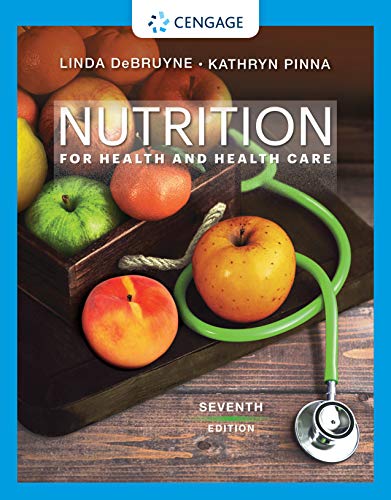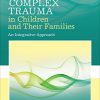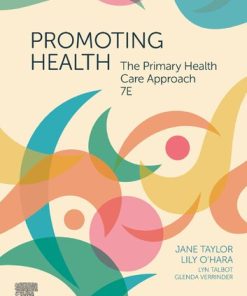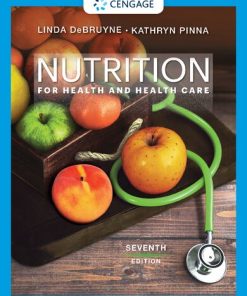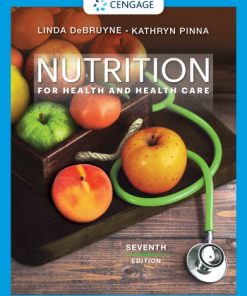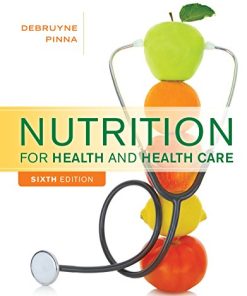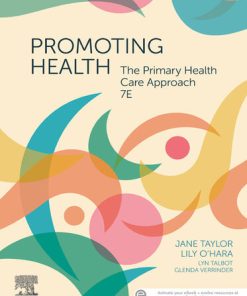Nutrition for Health and Health Care (MindTap Course List) 7th Edition, (Ebook PDF)
$50.00 Original price was: $50.00.$25.00Current price is: $25.00.
Nutrition for Health and Health Care (MindTap Course List) 7th Edition, (Ebook PDF) – Digital Instant Dowload.
Nutrition for Health and Health Care (MindTap Course List) 7th Edition, (Ebook PDF) – Digital Instant Dowload.

Product details:
- ISBN-10 : 0357022467
- ISBN-13 : 978-0357022467
- Author: Kathryn Pinna (Author), Linda DeBruyne (Author)
How does nutrition factor into nursing and health care careers? Find out with NUTRITION FOR HEALTH AND HEALTH CARE, 7th Edition! Packed with the latest clinical know-how, this resource enables you to leverage the power of diet therapy to make a real impact on patient lives. You uncover the science behind macro-nutrients, vitamins, minerals and metabolism, along with the many ways nutrition affects drugs, diseases and the human life cycle. And to support your success, the interactive MindTap platform features nutrition and diet therapy case studies, N.C.L.E.X.-style practice problems, the Diet & Wellness Plus app for setting and tracking nutritional goals–even an ebook that can read aloud to you!
Table contents:
Chapter 1: Overview of Nutrition and Health
1.1 Food Choices
1.2 The Nutrients
1.3 Nutrient Recommendations
1.4 National Nutrition Surveys
1.5 Dietary Guidelines, Fitness Guidelines, and Food Guides
1.6 Food Labels
1.7 Nutrition in Practice: Finding the Truth about Nutrition
Chapter 2: Digestion and Absorption
2.1 Anatomy of the Digestive Tract
2.2 The Process of Digestion
2.3 The Absorptive System
2.4 Transport of Nutrients
2.5 The Health and Regulation of the GI Tract
2.6 Nutrition in Practice: Food Safety
Chapter 3: Carbohydrates
3.1 The Chemist’s View of Carbohydrates
3.2 Digestion and Absorption of Carbohydrates
3.3 Regulation of Blood Glucose
3.4 Health Effects of Sugars and Alternative Sweeteners
3.5 Health Effects of Starch and Dietary Fibers
3.6 Nutrition in Practice: The Glycemic Index in Nutrition Practice
Chapter 4: Lipids
4.1 Roles of Body Fat
4.2 The Chemist’s View of Lipids
4.3 Digestion and Absorption of Lipids
4.4 Health Effects and Recommended Intakes of Fats
4.5 Fats in Foods
4.6 Nutrition in Practice: Figuring Out Fats
Chapter 5: Protein
5.1 The Chemist’s View of Proteins
5.2 Protein Digestion and Absorption
5.3 Protein Turnover and Nitrogen Balance
5.4 Roles of Body Proteins
5.5 Protein and Health
5.6 Protein in Foods
5.7 Nutrition in Practice: Vegetarian Diets
Chapter 6: Energy Balance and Body Composition
6.1 Energy Imbalance
6.2 Energy Balance
6.3 Body Weight and Body Composition
6.4 Health Risks of Underweight and Obesity
6.5 Nutrition in Practice: Eating Disorders
Chapter 7: Weight Management
7.1 Causes of Obesity
7.2 Obesity Treatment: Who Should Lose?
7.3 Inappropriate Obesity Treatments
7.4 Aggressive Treatments of Obesity
7.5 Reasonable Strategies for Weight Loss
7.6 Strategies for Weight Gain
7.7 Nutrition in Practice: Fad Diets
Chapter 8: The Vitamins
8.1 The Vitamins – An Overview
8.2 The Fat-Soluble Vitamins
8.3 The Water-Soluble Vitamins
8.4 Nutrition in Practice: Phytochemicals and Functional Foods
Chapter 9: Water and the Minerals
9.1 Water and Body Fluids
9.2 The Major Minerals
9.3 The Trace Minerals
9.4 Nutrition in Practice: Vitamin and Mineral Supplements
Chapter 10: Nutrition through the Life Span: Pregnancy and Lactation
10.1 Pregnancy: The Impact of Nutrition on the Future
10.2 Breastfeeding
10.3 Nutrition in Practice: Encouraging Successful Breastfeeding
Chapter 11: Nutrition through the Life Span: Infancy, Childhood, and Adolescence
11.1 Nutrition of the Infant
11.2 Nutrition during Childhood
11.3 Nutrition during Adolescence
11.4 Nutrition in Practice: Childhood Obesity and the Early Development of Chronic Diseases
Chapter 12: Nutrition through the Life Span: Later Adulthood
12.1 Nutrition and Longevity
12.2 Nutrition-Related Concerns during Late Adulthood
12.3 Energy and Nutrient Needs during Late Adulthood
12.4 Food Choices and Eating Habits of Older Adults
12.5 Nutrition in Practice: Hunger and Community Nutrition
Chapter 13: Nutrition Care and Assessment
13.1 Nutrition in Health Care
13.2 Nutrition Assessment
13.3 Nutrition in Practice: Nutritional Genomics
Chapter 14: Nutrition Intervention and Diet-Drug Interactions
14.1 Implementing Nutrition Care
14.2 Dietary Modifications
14.3 Foodservice
14.4 Diet-Drug Interactions
14.5 Nutrition in Practice: Complementary and Alternative Therapies
Chapter 15: Enteral and Parenteral Nutrition Support
15.1 Enteral Nutrition
15.2 Parenteral Nutrition
15.3 Nutrition Support at Home
15.4 Nutrition in Practice: Inborn Errors of Metabolism
Chapter 16: Nutrition in Metabolic and Respiratory Stress
16.1 The Body’s Responses to Stress and Injury
16.2 Nutrition Treatment of Acute Stress
16.3 Nutrition and Respiratory Stress
16.4 Nutrition in Practice: Multiple Organ Dysfunction Syndrome
Chapter 17: Nutrition and Upper Gastrointestinal Disorders
17.1 Conditions Affecting the Mouth and Esophagus
17.2 Conditions Affecting the Stomach
17.3 Gastric Surgery
17.4 Nutrition in Practice: Nutrition and Oral Health
Chapter 18: Nutrition and Lower Gastrointestinal Disorders
18.1 Common Intestinal Problems
18.2 Malabsorption
18.3 Disorders of the Pancreas
18.4 Disorders of the Small Intestine
18.5 Disorders of the Large Intestine
18.6 Nutrition in Practice: Probiotics and Intestinal Health
Chapter 19: Nutrition and Liver Diseases
19.1 Fatty Liver and Hepatitis
19.2 Cirrhosis
19.3 Liver Transplantation
19.4 Nutrition in Practice: Alcohol in Health and Disease
Chapter 20: Nutrition and Diabetes Mellitus
20.1 Overview of Diabetes Mellitus
20.2 Treatment of Diabetes Mellitus
20.3 Diabetes Management in Pregnancy
20.4 Nutrition in Practice: The Metabolic Syndrome
Chapter 21: Nutrition and Cardiovascular Diseases
21.1 Atherosclerosis
21.2 Coronary Heart Disease
21.3 Stroke
21.4 Hypertension
21.5 Heart Failure
21.6 Nutrition in Practice: Helping People with Feeding Disabilities
Chapter 22: Nutrition and Renal Diseases
22.1 Nephrotic Syndrome
22.2 Acute Kidney Injury
22.3 Chronic Kidney Disease
22.4 Kidney Stones
22.5 Nutrition in Practice: Dialysis
Chapter 23: Nutrition, Cancer, and HIV Infection
23.1 Cancer
23.2 HIV Infection
23.3 Nutrition in Practice: Ethical Issues in Nutrition Care
You may also like…
Medicine - Health-Related Professions
Medicine - Nursing
Promoting Health: The Primary Health Care Approach 7th Edition Jane Taylor
Relationships & Lifestyle - Diet & Nutrition
Nutrition for Sport and Exercise (MindTap Course List) 5th Edition
Medicine - Therapy
Medicine & Health Science
Nutrition for Health and Health Care 6th Edition, (Ebook PDF)
Medicine - Clinical Medicine
Health Professions and Academia: How to Begin Your CareerJohn Paul (J.P) Sánchez
Medicine - Health-Related Professions
Promoting Health The Primary Health Care Approach 7th Edition Jane Taylor


